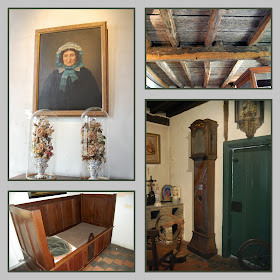
The sun was shining for our second day in Brussels (see our first day here.) Our friends decided to take us to Anderlecht, one of the nineteen municipalities located within Brussels. It is officially bilingual – French and Flemish. There, we were to visit a “béguinage” (French) or “begijnhof” (Flemish) which is a collection of small houses where “béguines” lived centuries ago.

Following a narrow path we entered the museum. A very friendly docent first explained the history of the béguinage to us. During the Middle Ages adult women were expected to live under the care of a man, as wife and mother, or in a convent as a nun. After the Crusades many women were left alone as widows without a man’s protection. Béguinage were set up for them - they were usually within a walled enclosure, close to a church, containing little houses, gardens, etc. These were Catholic lay religious communities. There was no mother-house, nor common general rule, every community of béguines fixed their own living regulations – they were medieval communes, if you will, or a sisterhood. Rich or poor women could enter a béguinage. A béguine was not a nun and took no vows. She did not renounce her property, but could return to the world and wed if she wished.
 Portrait of a Béguine, Hans Holbein the Younger, German, 1497-1543
Portrait of a Béguine, Hans Holbein the Younger, German, 1497-1543Some béguinage were large, such as the great béguinage in Ghent, Belgium, with thousands living there or small like the béguinage in Anderlecht, where we were visiting. Actually this was the smallest béguinage in Belgium occupied by only eight béguines. The Anderlecht béguinage consists of a collection of small houses built between 1252 and the 18th century. The béguines had direct access to the nearby Church of St. Guidon, built in the 16th century.

a room for lace-workers

a “bollewinkel” or delicacy store

and a small bedroom.

Then we walked into the left wing which had larger rooms for richer béguines.

We could also see, behind a glass window, a private chapel for the eight beguines. Béguines in the Low Countries were a religious group of women dedicated to charity and chastity but since they existed without men the Church did not approve of them – they had too much freedom and were suspect. Some were persecuted.

I liked looking out of the windows and think of the béguines, imagining them behind those same windows looking outside toward the sunny garden – did they feel entirely safe?

Upstairs, on the second floor there was a baby bed, an old stove, an old game,

other ancient objects that were found during archeological digs

as well as some colorful drawings of life in the area

and paintings without the names of the artists.

There were also some old photographs showing the history of Anderlecht, which is now the westernmost municipality of Brussels and the only one with some rural areas. But I did not take their pictures as we had to leave. I took a last look at the roses in the garden.

Years ago I remember seeing another béguinage, called Begijnhof, in Amsterdam, Holland. It was larger, not a museum, and now is owned by a church.
 Begijnhof in Amsterdam, Holland (Wikipedia photo)
Begijnhof in Amsterdam, Holland (Wikipedia photo)The small béguinage of Anderlecht had been fun to visit. This little semi-monastic commune is a little peaceful haven in Brussels, the dynamic European capital. While reading the history of Anderlecht I found out that one of my favorite singers, when I was in France, had lived there. Jacques Brel (1929-1978) a popular francophone singer, lived in Anderlecht from 1942 to 1951 and worked in his parents' factory there from 1946 to 1953. Jacques Brel was one of the greatest songwriters of all time. He wrote many songs, directed and acted. He was a musical genius, really.
 Jacques Brel (unknown photo owner)
Jacques Brel (unknown photo owner)I remember listening to his songs, again and again. One of his songs “Marieke” was in French and Flemish. I loved that song so much that I decided then, if ever I had a daughter, I would give her that name. Indeed, when my eldest daughter was born in San Francisco, her 3rd name is Marieke. She carries a little bit of Belgium in her.

